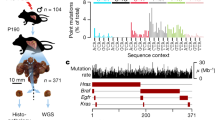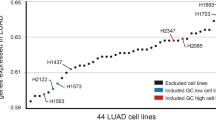Abstract
Homologous recombination can induce tumorigenic sequence rearrangements. Here, we show that persistent hyper-recombination can be induced following exposure to a bifunctional alkylating agent, mitomycin C (MMC), and that the progeny of exposed cells induce a hyper-recombination phenotype in unexposed neighboring cells. Residual damage cannot be the cause of delayed recombination events, since recombination is observed after drug and template damage are diluted over a million-fold. Furthermore, not only do progeny of MMC-exposed cells induce recombination in unexposed cells (bystanders), but these bystanders can in turn induce recombination in their unexposed neighbors. Thus, a signal to induce homologous recombination can be passed from cell to cell. Although the underlying molecular mechanism is not yet known, these studies reveal that cells suffer consequences of damage long after exposure, and that can signal unexposed neighboring cells to respond similarly. Thus, a single acute exposure to a chemotherapeutic agent can cause long-term changes in genomic stability. If the results of these studies of mouse embryonic stem (ES) cells are generally applicable to many cell types, these results suggest that a relatively small number of cells could potentially induce a tissue-wide increase in the risk of de novo homologous recombination events.
This is a preview of subscription content, access via your institution
Access options
Subscribe to this journal
Receive 50 print issues and online access
$259.00 per year
only $5.18 per issue
Buy this article
- Purchase on Springer Link
- Instant access to full article PDF
Prices may be subject to local taxes which are calculated during checkout





Similar content being viewed by others
References
Aubrecht J, Rugo R and Schiestl RH . (1995). Carcinogenesis, 16, 2841–2846.
Auerbach C . (1946). Proc. Roy. Soc. Edinburgh B, 62, 211–222.
Azzam EI, de Toledo SM, Gooding T and Little JB . (1998). Radiat. Res., 150, 497–504.
Bishop AJ and Schiestl RH . (2000). Hum. Mol. Genet., 9, 2334–2427.
Bishop AJ and Schiestl RH . (2003). Exp. Mol. Pathol., 74, 94–105.
Brennan RJ and Schiestl RH . (2001). Radiat. Res., 155, 768–777.
Camenisch G, Gruber M, Donoho G, Van Sloun P, Wenger RH and Gassmann M . (1996). Nucleic Acids Res., 24, 3707–3713.
Clutton SM, Townsend KM, Walker C, Ansell JD and Wright EG . (1996). Carcinogenesis, 17, 1633–1639.
Engelward B, Dreslin A, Christensen J, Huszar D, Kurahara C and Samson L . (1996). EMBO J., 15, 945–952.
Friedberg EC, Walker GC and Siede W . (1995). DNA Repair and Mutagenesis. ASM Press: Washington, DC.
Gupta PK, Sahota A, Boyadjiev SA, Bye S, Shao C, O'Neill JP, Hunter TC, Albertini RJ, Stambrook PJ and Tischfield JA . (1997). Cancer Res., 57, 1188–1193.
Helleday T . (2003). Mutat. Res., 532, 103–115.
Hendricks CA, Almeida KH, Stitt MS, Jonnalagadda VS, Rugo RE, Kerrison GF and Engelward BP . (2003). Proc. Natl. Acad. Sci. USA, 100, 6325–6330.
Huang L, Grim S, Smith LE, Kim PM, Nickoloff JA, Goloubeva OG and Morgan WF . (2004). Mol. Cell. Biol., 24, 5060–5068.
Huo L, Nagasawa H and Little JB . (2001). Radiat. Res., 156, 521–525.
Iyer R, Lehnert BE and Svensson R . (2000). Cancer Res., 60, 1290–1298.
Jonnalagadda VS, Matsuguchi T and Engelward BP . (2005). DNA Repair (in press).
Kadhim MA, Macdonald DA, Goodhead DT, Lorimore SA, Marsden SJ and Wright EG . (1992). Nature, 355, 738–740.
Kraus E, Leung WY and Haber JE . (2001). Proc. Natl. Acad. Sci. USA, 98, 8255–8262.
Lehnert BE, Goodwin EH and Deshpande A . (1997). Cancer Res., 57, 2164–2171.
Limoli CL, Hartmann A, Shephard L, Yang CR, Boothman DA, Bartholomew J and Morgan WF . (1998). Cancer Res., 58, 3712–3718.
Little JB . (2003). Oncogene, 22, 6978–6987.
Little JB, Gorgojo L and Vetrovs H . (1990). Int. J. Radiat. Oncol. Biol. Phys., 19, 1425–1429.
Liu-Lee VW, Heddle JA, Arlett CF and Broughton B . (1984). Mutat. Res., 127, 139–147.
Loeb LA . (1991). Cancer Res., 51, 3075–3079.
Lorimore SA and Wright EG . (2003). Int. J. Radiat. Biol., 79, 15–25.
Lyng FM, Seymour CB and Mothersill C . (2002). Radiat. Res., 157, 365–370.
McGlynn P and Lloyd RG . (2002). Nat. Rev. Mol. Cell. Biol., 3, 859–870.
Morgan WF . (2003). Oncogene, 22, 7094–7099.
Morgan WF, Day JP, Kaplan MI, McGhee EM and Limoli CL . (1996). Radiat. Res., 146, 247–258.
Morley AA, Grist SA, Turner DR, Kutlaca A and Bennett G . (1990). Cancer Res., 50, 4584–4587.
Mothersill C, Crean M, Lyons M, McSweeney J, Mooney R, O'Reilly J and Seymour CB . (1998). Int. J. Radiat. Biol., 74, 673–680.
Mothersill C and Seymour CB . (2004). Nat. Rev. Cancer., 4, 158–164.
Moynahan ME and Jasin M . (1997). Proc. Natl. Acad. Sci. USA, 94, 8988–8993.
Nagasawa H, Cremesti A, Kolesnick R, Fuks Z and Little JB . (2002). Cancer Res., 62, 2531–2534.
Nagasawa H and Little JB . (1992). Cancer Res., 52, 6394–6396.
Nagasawa H and Little JB . (1999). Radiat. Res., 152, 552–557.
Nagasawa H, Little JB, Inkret WC, Carpenter S, Raju MR, Chen DJ and Strniste GF . (1991). Radiat. Res., 126, 280–288.
Narayanan PK, Goodwin EH and Lehnert BE . (1997). Cancer Res., 57, 3963–3971.
Niedernhofer LJ, Odijk H, Budzowska M, van Drunen E, Maas A, Theil AF, de Wit J, Jaspers NG, Beverloo HB, Hoeijmakers JH and Kanaar R . (2004). Mol. Cell. Biol., 24, 5776–5787.
Ohtsuru M, Ishii Y, Takai S, Higashi H and Kosaki G . (1980). Cancer Res., 40, 477–480.
Okabe M, Ikawa M, Kominami K, Nakanishi T and Nishimune Y . (1997). FEBS Lett., 407, 313–319.
Pampfer S and Streffer C . (1989). Int. J. Radiat. Biol., 55, 85–92.
Paques F and Haber JE . (1999). Microbiol. Mol. Biol. Rev., 63, 349–404.
Sasaki MS, Takata M, Sonoda E, Tachibana A and Takeda S . (2004). Cytogenet. Genome Res., 104, 28–34.
Schmid CW . (1996). Prog. Nucleic Acid Res. Mol. Biol., 53, 283–319.
Shao C, Deng L, Henegariu O, Liang L, Raikwar N, Sahota A, Stambrook PJ and Tischfield JA . (1999). Proc. Natl. Acad. Sci. USA, 96, 9230–9235.
Sobol RW, Kartalou M, Almeida KH, Joyce DF, Engelward BP, Horton JK, Prasad R, Samson LD and Wilson SH . (2003). J. Biol. Chem., 278, 39951–39959.
Stetka DG, Minkler J and Carrano AV . (1978). Mutat. Res., 51, 383–396.
Suzuki K, Yokoyama S, Waseda S, Kodama S and Watanabe M . (2003). Cancer Res., 63, 936–941.
Thompson LH and Schild D . (2002). Mutat. Res., 509, 49–78.
Tomasz M, Lipman R, Chowdary D, Pawlak J, Verdine GL and Nakanishi K . (1987). Science, 235, 1204–1208.
van der Lugt N, Maandag ER, te Riele H, Laird PW and Berns A . (1991). Gene, 105, 263–267.
West SC . (2003). Nat. Rev. Mol. Cell. Biol., 4, 435–445.
Wilson VL and Jones PA . (1983). Cell, 32, 239–246.
Zhou H, Randers-Pehrson G, Waldren CA, Vannais D, Hall EJ and Hei TK . (2000). Proc. Natl. Acad. Sci. USA, 97, 2099–2104.
Zhu X, Dunn JM, Goddard AD, Squire JA, Becker A, Phillips RA and Gallie BL . (1992). Cytogenet. Cell. Genet., 59, 248–252.
Acknowledgements
For assistance in statistics, we thank Dr AJ Engelward of the Department of Mathematics, Harvard University. We thank Laura Trudel for technical help in the preparation of this manuscript and Dr E Spek for assistance in creating the HPRT targeting construct and for helpful comments on the manuscript. We thank Laurel Vuong and Jeff Loh for technical support in developing the fluorescence based recombination assay. The Engelward lab is supported by CA84740 and the Burroughs Wellcome Fund. We thank L Samson and the MIT Center for Environmental Health Sciences for supporting this work (P30-ES02109).
Author information
Authors and Affiliations
Corresponding author
Rights and permissions
About this article
Cite this article
Rugo, R., Almeida, K., Hendricks, C. et al. A single acute exposure to a chemotherapeutic agent induces hyper-recombination in distantly descendant cells and in their neighbors. Oncogene 24, 5016–5025 (2005). https://doi.org/10.1038/sj.onc.1208690
Received:
Revised:
Accepted:
Published:
Issue Date:
DOI: https://doi.org/10.1038/sj.onc.1208690
Keywords
This article is cited by
-
Adaptive responses to low doses of radiation or chemicals: their cellular and molecular mechanisms
Cellular and Molecular Life Sciences (2019)
-
Methyltransferases mediate cell memory of a genotoxic insult
Oncogene (2011)
-
Mitochondrial mutagenesis induced by tumor-specific radiation bystander effects
Journal of Molecular Medicine (2010)
-
Mitomycin C induces bystander killing in homogeneous and heterogeneous hepatoma cellular models
Molecular Cancer (2009)
-
Irradiation induces DNA damage and modulates epigenetic effectors in distant bystander tissue in vivo
Oncogene (2006)



